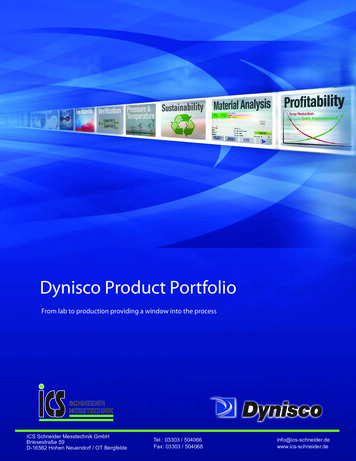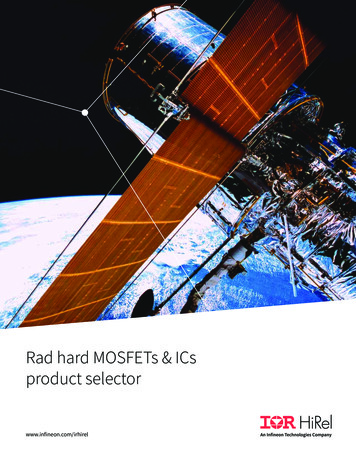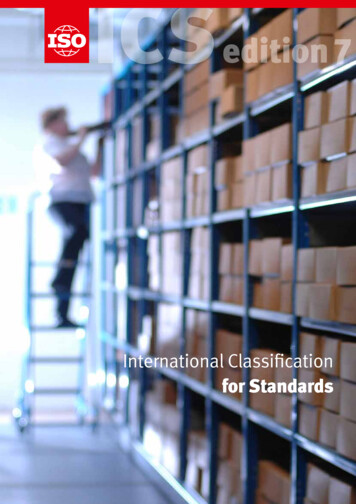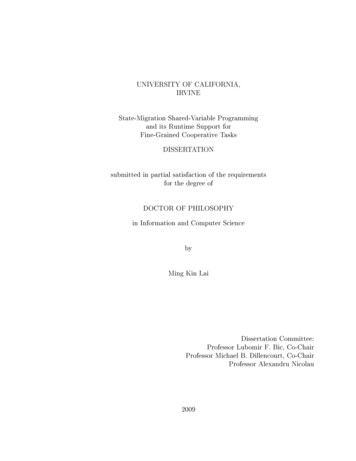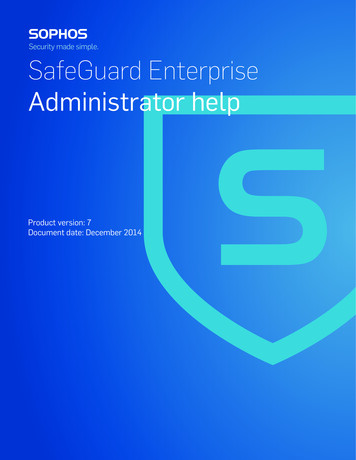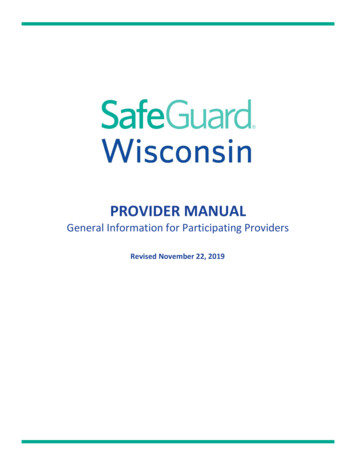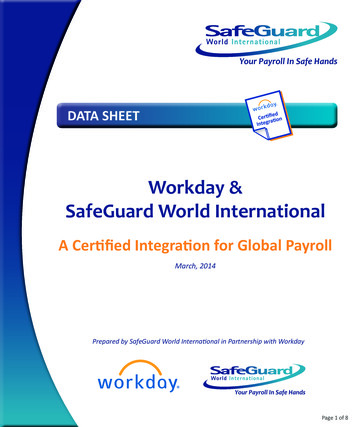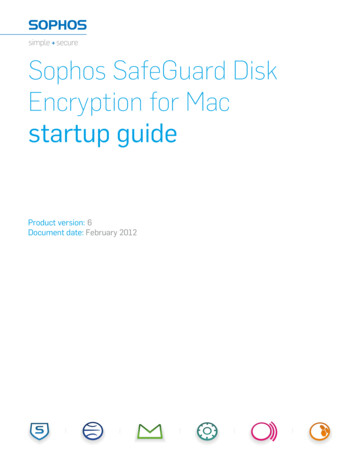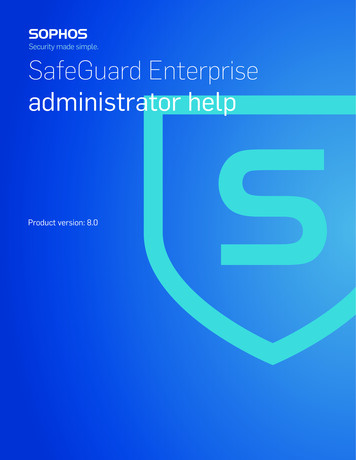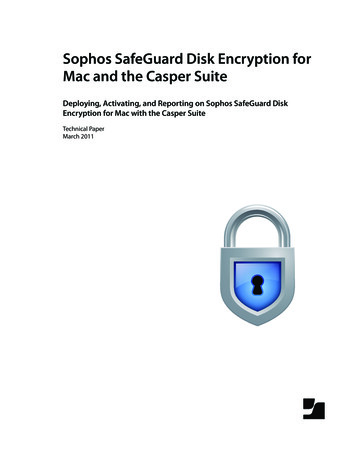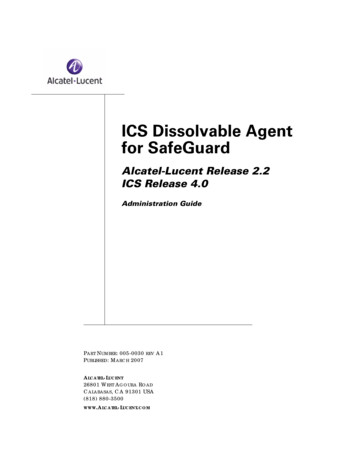
Transcription
ICS Dissolvable Agentfor SafeGuardAlcatel-Lucent Release 2.2ICS Release 4.0Administration GuidePART NUMBER: 005-0030 REV A1PUBLISHED: MARCH 2007ALCATEL-LUCENT26801 WEST AGOURA ROADCALABASAS, CA 91301 USA(818) 880-3500WWW.ALCATEL-LUCENT.COM
Alcatel-Lucent ProprietaryCopyright 2007 Alcatel-Lucent. All rights reserved. This document may not be reproduced in wholeor in part without the expressed written permission Alcatel-Lucent. Alcatel-Lucent and the AlcatelLucent logo are registered trademarks of Alcatel-Lucent. All other trademarks are the property of theirrespective owners.2ICS Dissolvable Agent for SafeGuard Administration Guide
ContentsPrefaceAbout this Guide . . . . . . . . . . . . . . . . . . . . . . . . . . . . . . . . . . . . . . . . . . . . . . . . . . . . . . . . . . . . . . . . . . . 6Related Publications. . . . . . . . . . . . . . . . . . . . . . . . . . . . . . . . . . . . . . . . . . . . . . . . . . . . . . . . . . . . . . . . 6Chapter 1: IntroductionIntegrity Clientless Security Features . . . . . . . . . . . . . . . . . . . . . . . . . . . . . . . . . . . . . . . . . . . . . . . . . . 10Integrity Clientless Security Scanner . . . . . . . . . . . . . . . . . . . . . . . . . . . . . . . . . . . . . . . . . . . . . . . 10Reports . . . . . . . . . . . . . . . . . . . . . . . . . . . . . . . . . . . . . . . . . . . . . . . . . . . . . . . . . . . . . . . . . . . . . . . . . . 10ICSInfo Utility. . . . . . . . . . . . . . . . . . . . . . . . . . . . . . . . . . . . . . . . . . . . . . . . . . . . . . . . . . . . . . . . . . . . . . 10Supported Features . . . . . . . . . . . . . . . . . . . . . . . . . . . . . . . . . . . . . . . . . . . . . . . . . . . . . . . . . . . . . . . 11Unsupported Features . . . . . . . . . . . . . . . . . . . . . . . . . . . . . . . . . . . . . . . . . . . . . . . . . . . . . . . . . . . . . 11Chapter 2: PrerequisitesEnd Point Prerequisites . . . . . . . . . . . . . . . . . . . . . . . . . . . . . . . . . . . . . . . . . . . . . . . . . . . . . . . . . . . . . 14Supported Operating Systems . . . . . . . . . . . . . . . . . . . . . . . . . . . . . . . . . . . . . . . . . . . . . . . . . . . 14Supported Browsers . . . . . . . . . . . . . . . . . . . . . . . . . . . . . . . . . . . . . . . . . . . . . . . . . . . . . . . . . . . . 14Java Requirements . . . . . . . . . . . . . . . . . . . . . . . . . . . . . . . . . . . . . . . . . . . . . . . . . . . . . . . . . . . . 14Chapter 3: General Administration TasksPlanning for Security . . . . . . . . . . . . . . . . . . . . . . . . . . . . . . . . . . . . . . . . . . . . . . . . . . . . . . . . . . . . . . . 16Security Scenario . . . . . . . . . . . . . . . . . . . . . . . . . . . . . . . . . . . . . . . . . . . . . . . . . . . . . . . . . . . . . . 16Vulnerabilities . . . . . . . . . . . . . . . . . . . . . . . . . . . . . . . . . . . . . . . . . . . . . . . . . . . . . . . . . . . . . . 16Risks . . . . . . . . . . . . . . . . . . . . . . . . . . . . . . . . . . . . . . . . . . . . . . . . . . . . . . . . . . . . . . . . . . . . . . 17End Point Users and Disruption Tolerance . . . . . . . . . . . . . . . . . . . . . . . . . . . . . . . . . . . . . . . 17Sample Solution . . . . . . . . . . . . . . . . . . . . . . . . . . . . . . . . . . . . . . . . . . . . . . . . . . . . . . . . . . . . 17Understanding Security Lifecycles . . . . . . . . . . . . . . . . . . . . . . . . . . . . . . . . . . . . . . . . . . . . . . . . 17Supporting the End Point User. . . . . . . . . . . . . . . . . . . . . . . . . . . . . . . . . . . . . . . . . . . . . . . . . . . . 19Logging In . . . . . . . . . . . . . . . . . . . . . . . . . . . . . . . . . . . . . . . . . . . . . . . . . . . . . . . . . . . . . . . . . . . . . . . 19Configuration Workflow . . . . . . . . . . . . . . . . . . . . . . . . . . . . . . . . . . . . . . . . . . . . . . . . . . . . . . . . . . . . 20General Administration Tasks. . . . . . . . . . . . . . . . . . . . . . . . . . . . . . . . . . . . . . . . . . . . . . . . . . . . . . . . 20Configuring ICS to Fail Open. . . . . . . . . . . . . . . . . . . . . . . . . . . . . . . . . . . . . . . . . . . . . . . . . . . . . 21Configuring Updates . . . . . . . . . . . . . . . . . . . . . . . . . . . . . . . . . . . . . . . . . . . . . . . . . . . . . . . . . . . 21ICS Dissolvable Agent for SafeGuard Administration Guide3
ContentsChapter 4: Administering Security Scanner PoliciesUnderstanding Integrity Clientless Security Scanner. . . . . . . . . . . . . . . . . . . . . . . . . . . . . . . . . . . . . 24Implementing Policies . . . . . . . . . . . . . . . . . . . . . . . . . . . . . . . . . . . . . . . . . . . . . . . . . . . . . . . . . . . . . 24Understanding Enforcement Rules . . . . . . . . . . . . . . . . . . . . . . . . . . . . . . . . . . . . . . . . . . . . . . . . . . . 24Enforcement Rule Types . . . . . . . . . . . . . . . . . . . . . . . . . . . . . . . . . . . . . . . . . . . . . . . . . . . . . . . . 25Firewall Application Rules . . . . . . . . . . . . . . . . . . . . . . . . . . . . . . . . . . . . . . . . . . . . . . . . . . . . . . . 26Creating a Firewall Application Rule . . . . . . . . . . . . . . . . . . . . . . . . . . . . . . . . . . . . . . . . . . . 26Anti-virus Application Rules . . . . . . . . . . . . . . . . . . . . . . . . . . . . . . . . . . . . . . . . . . . . . . . . . . . . . . 27Creating an Anti-virus Application Rule . . . . . . . . . . . . . . . . . . . . . . . . . . . . . . . . . . . . . . . . 27Anti-Spyware Scan Rules . . . . . . . . . . . . . . . . . . . . . . . . . . . . . . . . . . . . . . . . . . . . . . . . . . . . . . . . 29Creating an Anti-spyware Rule . . . . . . . . . . . . . . . . . . . . . . . . . . . . . . . . . . . . . . . . . . . . . . . 29Custom Application Rules . . . . . . . . . . . . . . . . . . . . . . . . . . . . . . . . . . . . . . . . . . . . . . . . . . . . . . . 30Custom Group Rules . . . . . . . . . . . . . . . . . . . . . . . . . . . . . . . . . . . . . . . . . . . . . . . . . . . . . . . . . . . 31Creating Custom Group Rules . . . . . . . . . . . . . . . . . . . . . . . . . . . . . . . . . . . . . . . . . . . . . . . . 31Creating Policies . . . . . . . . . . . . . . . . . . . . . . . . . . . . . . . . . . . . . . . . . . . . . . . . . . . . . . . . . . . . . . . . . . 32Activating Policies. . . . . . . . . . . . . . . . . . . . . . . . . . . . . . . . . . . . . . . . . . . . . . . . . . . . . . . . . . . . . . . . . 32Chapter 5: ReportsReports . . . . . . . . . . . . . . . . . . . . . . . . . . . . . . . . . . . . . . . . . . . . . . . . . . . . . . . . . . . . . . . . . . . . . . . . . . 36Generating Reports . . . . . . . . . . . . . . . . . . . . . . . . . . . . . . . . . . . . . . . . . . . . . . . . . . . . . . . . . . . . 36Access Statistics . . . . . . . . . . . . . . . . . . . . . . . . . . . . . . . . . . . . . . . . . . . . . . . . . . . . . . . . . . . . . . . 37Security Scan Results . . . . . . . . . . . . . . . . . . . . . . . . . . . . . . . . . . . . . . . . . . . . . . . . . . . . . . . . . . . 37Spyware Found . . . . . . . . . . . . . . . . . . . . . . . . . . . . . . . . . . . . . . . . . . . . . . . . . . . . . . . . . . . . . . . . 37Rules Broken . . . . . . . . . . . . . . . . . . . . . . . . . . . . . . . . . . . . . . . . . . . . . . . . . . . . . . . . . . . . . . . . . . 37Anti-Keylogger . . . . . . . . . . . . . . . . . . . . . . . . . . . . . . . . . . . . . . . . . . . . . . . . . . . . . . . . . . . . . . . . 37Errors . . . . . . . . . . . . . . . . . . . . . . . . . . . . . . . . . . . . . . . . . . . . . . . . . . . . . . . . . . . . . . . . . . . . . . . . . 38Chapter 6: The ICSInfo UtilityTroubleshooting End Point User Issues. . . . . . . . . . . . . . . . . . . . . . . . . . . . . . . . . . . . . . . . . . . . . . . . . 40Obtaining Anti-virus Application Information . . . . . . . . . . . . . . . . . . . . . . . . . . . . . . . . . . . . . . . 41Obtaining Application Checksums . . . . . . . . . . . . . . . . . . . . . . . . . . . . . . . . . . . . . . . . . . . . . . . 414ICS Dissolvable Agent for SafeGuard Administration Guide
PrefaceIn this preface: About this GuideRelated Publications
PrefaceAbout this GuideThis preface provides an overview of Integrity Clientless Security (ICS) documentation asimplemented and integrated into the Alcatel-Lucent OmniAccess SafeGuard OS solution.The ICS Dissolvable Agent for SafeGuard Administration Guide provides: Prerequisites Administration information, including background and task-orientedadministrative procedures Information about using the various utilities included with Integrity ClientlessSecurityThis guide is tailored for running ICS only under OmniAccess SafeGuard OS. If you areusing a version of ICS available directly from Check Point Technologies, you should usethe documentation available from their Web site.Related PublicationsFor additional ICS information, see the Online Help. The online help provides the fieldlevel information you need to understand the UI elements in the ICS AdministratorConsole. The online help includes detailed information about what each element doesand what entries are valid. Use the online help after reading the procedural informationin the ICS for SafeGuard Administrator Guide. You can access the help from any page inthe ICS Administrator Console by clicking the help link.For information about configuring and managing the OmniAccess SafeGuard Controller,refer to the following guides: OmniAccess SafeGuard Controller Installation GuideDescribes the OmniAccess SafeGuard Controller. The guide provides detailedinstallation instructions and technical specifications for the OmniAccessSafeGuard Controller. OmniVista SafeGuard Manager Administration GuideDescribes how to manage the OmniAccess SafeGuard Controller using theOmniVista SafeGuard Manager software. OmniAccess SafeGuard OS Administration GuideProvides concepts and configuration instructions for the major features ofOmniAccess SafeGuard OS and its supported products, which includes End PointValidation (EPV) the integral component for using ICS.6ICS Dissolvable Agent for SafeGuard Administration Guide
PrefaceThis guide uses the following formats to highlight special messages in the text:NOTE: This format highlights information that is important or that hasspecial interest.ICS Dissolvable Agent for SafeGuard Administration Guide7
Preface8ICS Dissolvable Agent for SafeGuard Administration Guide
chapter1IntroductionIn this chapter: Integrity Clientless Security FeaturesReportsICSInfo UtilityUnsupported Features
Chapter 1: IntroductionCheck Point Integrity Clientless Security (ICS) protects your network by scanning endpoint computers. Use it to do the following: Check end point computers for known spyware, worms, and other potentialthreats Check that end point computers are compliant with your anti-virus, firewall, andother software policies Protect data on end point computers from keyloggersIntegrity Clientless Security FeaturesICS consists of several features, each providing a unique type of security protection. Youcan choose which features to implement. This section provides an overview of thesefeatures.Integrity Clientless Security ScannerUse the Integrity Clientless Security Scanner policies to make sure that end pointcomputers connecting to your network meet your security requirements. The IntegrityClientless Security Scanner checks end point computers for applications according to theenforcement rules you create. Enforcement rules either prohibit or require certainapplications. If the end point computer does not meet the requirements of theenforcement rule, it is considered to be ‘non-compliant’. You can choose to restrict orwarn non-compliant users or simply log the event. For more detailed information aboutenforcement rules, see Understanding Enforcement Rules on page 24.ReportsUse reports to monitor how ICS is protecting your network and to plan new policies. Formore information about reports, see Reports on page 36.ICSInfo UtilityICS includes the ICSInfo Utility. The ICSInfo utility collects program and otherinformation from end point computers that you can use when creating your policies ortroubleshooting user issues. See Troubleshooting End Point User Issues on page 40.10ICS Dissolvable Agent for SafeGuard Administration Guide
Chapter 1: IntroductionSupported FeaturesThe ICS Dissolvable Agent has the following features: Enforces software compliance Detects browser plugins for adware Tool for dialer hacking Detects keystroke Logging Detects undesirable software Remote administration tool Screen logging Cookie tracking Detects Trojans Detects worms Enforces anti-virus compliance for these vendors:— Computer Associates VET— Computer Associates eTrust InnoculateIT— Kaspersky Antivirus— McAfee VirusScan— Trend Micro PC-cillin/OfficeScan— Sophos AV— Symantec Norton AntivirusUnsupported FeaturesThe following ICS features display in the product, but are not supported in the ICSDissolvable Agent for OmniAccess SafeGuard OS solution: While the spyware module does detect key-logging, the Advanced AntiKeyLogger feature of ICS is not supported. Integrity Secure WorkspaceICS Dissolvable Agent for SafeGuard Administration Guide11
Chapter 1: Introduction12ICS Dissolvable Agent for SafeGuard Administration Guide
chapter2PrerequisitesIn this chapter: End Point Prerequisites
Chapter 2: PrerequisitesEnd Point PrerequisitesUse this chapter to plan your ICS implementation by ensuring that you meet therequirements listed.For end point computers to be successfully serviced by Integrity Clientless Security, theymust meet the end point requirements outlined in this section. When a user tries to accessyour network without the proper browser or settings, an error message is displayeddetailing the browser requirements. You can choose to allow access for end pointcomputers that do not meet your requirements, however, those computers will not beserviced by ICS.Supported Operating SystemsFor information about allowing access for end point computers that are runningunsupported operating systems see Configuring ICS to Fail Open on page 21.For Integrity Security Scanner: Windows 98/ME Windows NT4 SP6 Windows 2000 Windows XPSupported Browsers Internet Explorer 5.01 or later configured to allow cookies, run ActiveXcomponents or Sun Java applets enabled or Microsoft Java VM enabled Mozilla Firefox 1.0 or later configured to allow cookies and Sun Java appletssupport enabled Netscape Navigator 8.0 or later configured to allow cookies and Sun Java appletssupport enabledJava RequirementsICS supports two Java implementations. End point computers must have one of thefollowing to be serviced by ICS:14 Sun JRE version 1.4.2 or higher. Microsoft JVM version 5.5.3810.0 or higher.ICS Dissolvable Agent for SafeGuard Administration Guide
chapter3General AdministrationTasksIn this chapter: Planning for SecurityLogging InConfiguration WorkflowGeneral Administration Tasks
Chapter 3: General Administration TasksPlanning for SecurityThis chapter provides information about the general administration of ICS. Before youstart to configure and administer ICS, you should consider which security features youwant to use and how they will affect your users. You should balance security with theability of your users to access your network. If you implement a large number of securityrequirements, then you will achieve high security; however, if the end point computersdo not comply, then your users will not be able to access your network. This can cause aconsiderable support burden and negatively impact productivity. Alternatively, if youconfigure ICS to be too lenient, you might not achieve the level of security you need.When planning your implementation, be sure to take into account your particularsecurity situation. ICS provides a variety of features to suit different needs. Depending onyour security goals and your users, you may use only a portion of those features. Use theinformation in Security Scenario on page 16, to determine which features are suitable foryour implementation.Even if you find that you need a very secure, very restrictive security implementation, itmay not be a good idea to immediately impose it upon your users. The recommendedway to achieve high security with lower user impact is to start with a less demandingconfiguration and then implement progressively more strict configurations in an iterativemanner. The process you use to manage these iterative configurations is called a ‘securitylifecycle’. For more information, see Understanding Security Lifecycles on page 17.Security ScenarioICS is designed to provide flexible configuration options that allow you to tailor itsprotection to your security needs. When deciding which ICS security solutions to use youshould consider the following: Security vulnerabilities Threats Type of end point users and disruption toleranceUse the following full network access security scenario to help plan yourimplementation. In this scenario, you are providing end point users with unlimitedaccess to your entire network.VulnerabilitiesIn this scenario, your entire network is vulnerable, including:16 Network resources File servers Application serversICS Dissolvable Agent for SafeGuard Administration Guide
Chapter 3: General Administration Tasks User accounts End point computersYour security goals are to provide data protection, session confidentiality, and protectionfrom network infection.RisksIn this scenario, your organization’s intellectual property is threatened by: Viruses Trojans Worms HackersEnd Point Users and Disruption ToleranceYour end point users are usually employees but they can also be guests and contractors.Employees are professionals with a medium-to-high level of computer expertise. Theyare more likely to understand the need for security and to tolerate a higher degree ofdisruption while becoming compliant with your security implementation’s demands.Sample SolutionA recommended solution for full network access is to use the ICS Security Scanner. TheSecurity Scanner protects against network infection and known spyware through thepolicy you configure. The Security Scanner policy should require an antivirus applicationand a firewall on each end point computer. The policy should also prohibit all types ofspyware.Although the final goal of this security solution is to have a rather demanding andrestrictive policy, you can minimize end point user disruption through the use of securitylifecycles. You can implement a limited number of security features at first and use morelenient options while your users become compliant. Once users have begun to comply,you can add more security features, and use the less permissive options. For moreinformation see Understanding Security Lifecycles.Understanding Security LifecyclesSecurity lifecycles allow you to gradually increase your security while maintainingreasonable user access to your network. By using a security lifecycle, you can also keepyour system up to date, by implementing changes according to changes in your systemssecurity needs.Consider starting out with a security configuration that is lenient. Strategies for creatingmore lenient security configurations include:ICS Dissolvable Agent for SafeGuard Administration Guide17
Chapter 3: General Administration Tasks Minimizing security features—Using only one or two features. To make thesefeatures less disruptive, allow end point computers to connect, even if theoperating systems are not supported by the feature. Minimizing enforcement rules—Only using enforcement rules for the mostimportant security requirements, such as requiring an antivirus application. Tomake these enforcement rules even less disruptive, set them to ‘warn’ or‘observe’.Use the following steps in your security lifecycle:1Plan your security implementation.Use the sample se
PART NUMBER: 005-0030 REV A1 PUBLISHED: MARCH 2007 ALCATEL-LUCENT 26801 WEST AGOURA ROAD CALABASAS, CA 91301 USA (818) 880-3500 WWW.ALCATEL-LUCENT.COM ICS Dissolvable Agent for SafeGuard Alcatel-Lucent Release 2.2 ICS Release 4.0 Administration Guide
